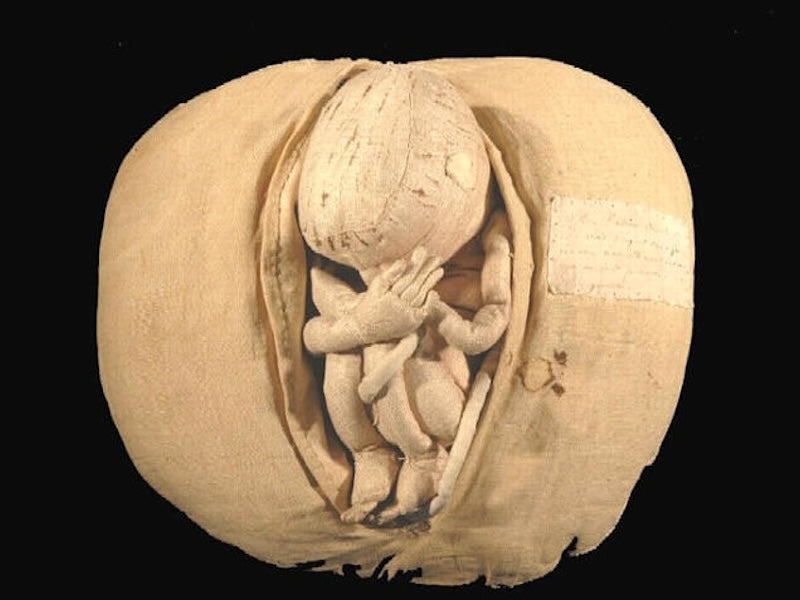
A Fabric Womb Made by Angélique du Coudray
Parisian midwife Angélique du Coudray played a pivotal role in the court of Louis XV. In 1759, the king initiated a project to reduce infant mortality rates and commissioned her to educate peasant women in midwifery. Between 1760 and 1783, she traveled extensively across France, visiting impoverished rural areas and imparting her vast knowledge. Du Coudray is estimated to have trained around 10,000 women. She also created the first life-sized obstetrical mannequin for practicing births she named "La Machine" and published a highly regarded midwifery textbook, Abrégé de l’art des accouchements (The Art of Obstetrics, 1759).
 "La Machine" by Angélique du Coudray.
"La Machine" by Angélique du Coudray.
To provide practical skills training "La Machine" was crafted from wood, fabric, and cardboard, with a pink covering to simulate skin. The mannequin featured the pelvis, genitalia, and upper thighs, as well as a removable uterus with a silk ribbon to replicate different stages of cervical dilation. The set included a life-size newborn, a seven-month-old fetus, and twins, which could be inserted into the mannequin to simulate both routine and complicated births. These fetal models were meticulously detailed, with anatomical features like the fontanel, enabling trainee midwives to practice essential skills such as palpation.
 "La Machine" by Angélique du Coudray.
"La Machine" by Angélique du Coudray.
Despite the advancements in training due to the popularisation of her pedagogical methods, du Coudray faced considerable criticism. Resistance came from traditional master midwives, who were reluctant to alter established midwifery education practices, and from the exclusively male scientific and medical establishment, which saw her innovations as encroaching on their domain.
La Machine by Angélique du Coudray is now preserved by Musée Flaubert d'Histoire de la Médecine, Rouen, France.

To provide practical skills training "La Machine" was crafted from wood, fabric, and cardboard, with a pink covering to simulate skin. The mannequin featured the pelvis, genitalia, and upper thighs, as well as a removable uterus with a silk ribbon to replicate different stages of cervical dilation. The set included a life-size newborn, a seven-month-old fetus, and twins, which could be inserted into the mannequin to simulate both routine and complicated births. These fetal models were meticulously detailed, with anatomical features like the fontanel, enabling trainee midwives to practice essential skills such as palpation.

Despite the advancements in training due to the popularisation of her pedagogical methods, du Coudray faced considerable criticism. Resistance came from traditional master midwives, who were reluctant to alter established midwifery education practices, and from the exclusively male scientific and medical establishment, which saw her innovations as encroaching on their domain.
La Machine by Angélique du Coudray is now preserved by Musée Flaubert d'Histoire de la Médecine, Rouen, France.
